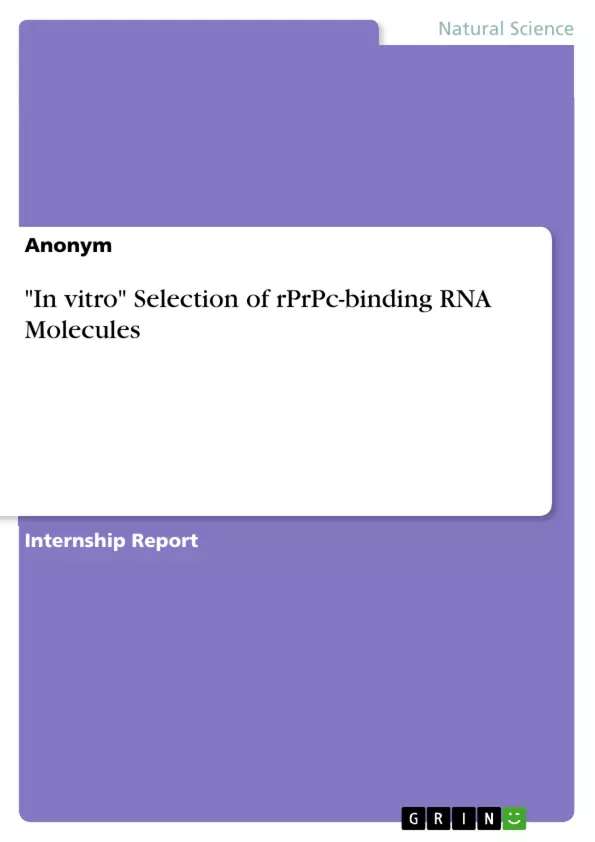Aptamers can be considered as nucleic acid based analogues of monoclonar antibodies. These DNA or RNA molecules are characterized by a high affinity and selectivity to the target as well as a huge variety of possible targets, but feature significant advantages compared to antibodies such as the lack of immunogenicity and economic in vitro generation.
The preparation of aptamers is based on systematic evolution (see figure 1). Cycles of selection and replication are conducted to narrow down a huge library to aptamers with the best binding properties to the target.
In this experiment, an RNA aptamer to the rPrPc protein is selected in vitro. Since a whole SELEX procedures takes several weeks, only one selection cycle is done examplarily.
Inhaltsverzeichnis (Table of Contents)
- Introduction
- Material and methods
- RNA preparation
- Protein preparation
- In vitro Selection
- Results
- RNA preparation
- T7 transcription
- Purification of the transcription product
- Protein purification
- Bradford assay of eluted fractions from Ni-NTA
- Analysis of protein purification by SDS-PAGE
- Analysis of PCR products by PAGE
- RNA preparation
- Discussion
- RNA preparation
- Protein preparation
- In vitro selection
Zielsetzung und Themenschwerpunkte (Objectives and Key Themes)
This experiment focuses on the in vitro selection of RNA aptamers that bind to the rPrP protein. The main objective is to perform one selection cycle of a SELEX procedure, demonstrating the process of identifying and isolating RNA molecules with high affinity for the target protein. Key themes explored in this work include:- Aptamer selection and the SELEX process
- RNA preparation and purification techniques
- Protein expression and purification methods
- In vitro selection of RNA molecules
- Applications of aptamers in biomedical research
Zusammenfassung der Kapitel (Chapter Summaries)
The introductory chapter provides a comprehensive overview of aptamers, their properties, and their potential applications. It discusses the SELEX process, outlining the steps involved in selecting and isolating aptamers. The chapter concludes by introducing the specific goal of the experiment: to select an RNA aptamer that binds to the rPrP protein. The "Material and methods" chapter details the experimental procedures used in the selection cycle. It covers the preparation of DNA templates, the T7 transcription process, the purification of RNA transcripts, and the protein expression and purification methods. The chapter also includes detailed protocols for the various techniques employed. The "Results" chapter presents the findings from the experiment, focusing on the RNA preparation and protein purification steps. It describes the transcription process, purification methods, and the analysis of protein purification by SDS-PAGE. The chapter provides a concise overview of the experimental outcomes, highlighting the successful execution of the selection cycle. The "Discussion" chapter interprets the results and discusses the implications of the findings. It examines the efficiency of the RNA preparation and protein purification techniques, analyzes the success of the selection cycle, and outlines the future directions for research in this area.Schlüsselwörter (Keywords)
The key terms and concepts central to this study include aptamers, SELEX, rPrP, RNA preparation, protein purification, in vitro selection, transcription, purification techniques, SDS-PAGE, and biomedical applications.- Quote paper
- Anonym (Author), 2014, "In vitro" Selection of rPrPc-binding RNA Molecules, Munich, GRIN Verlag, https://www.hausarbeiten.de/document/282478


